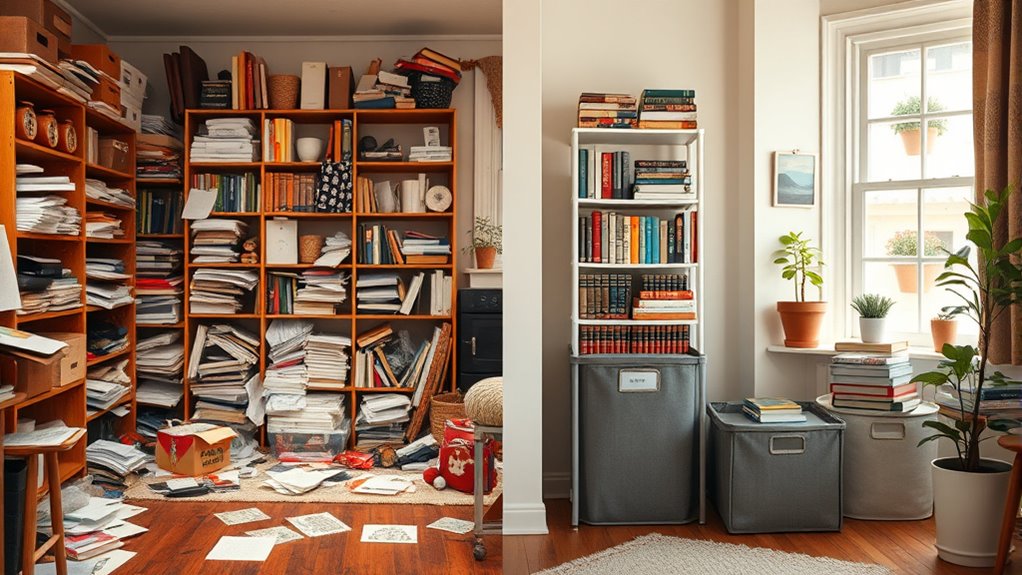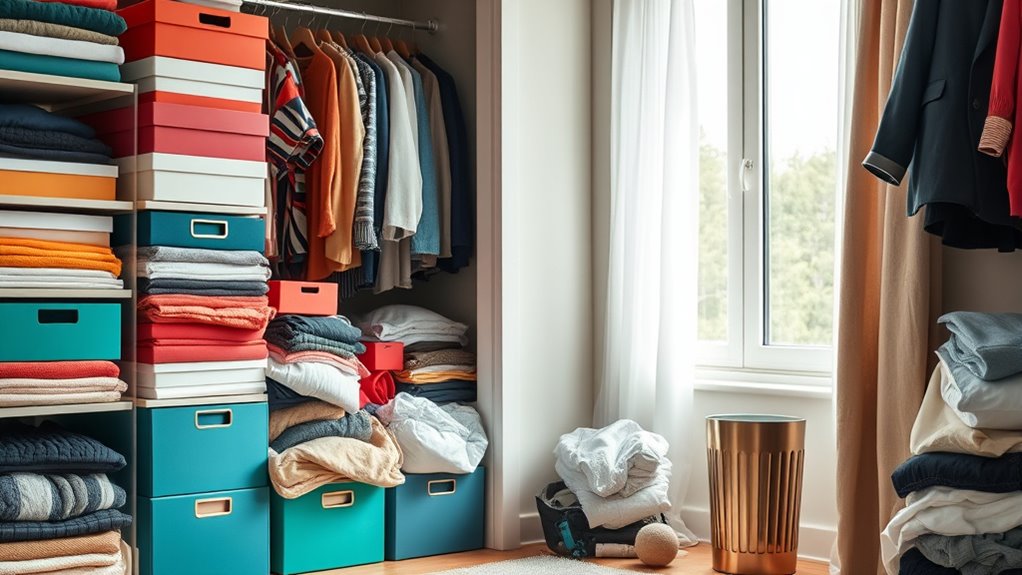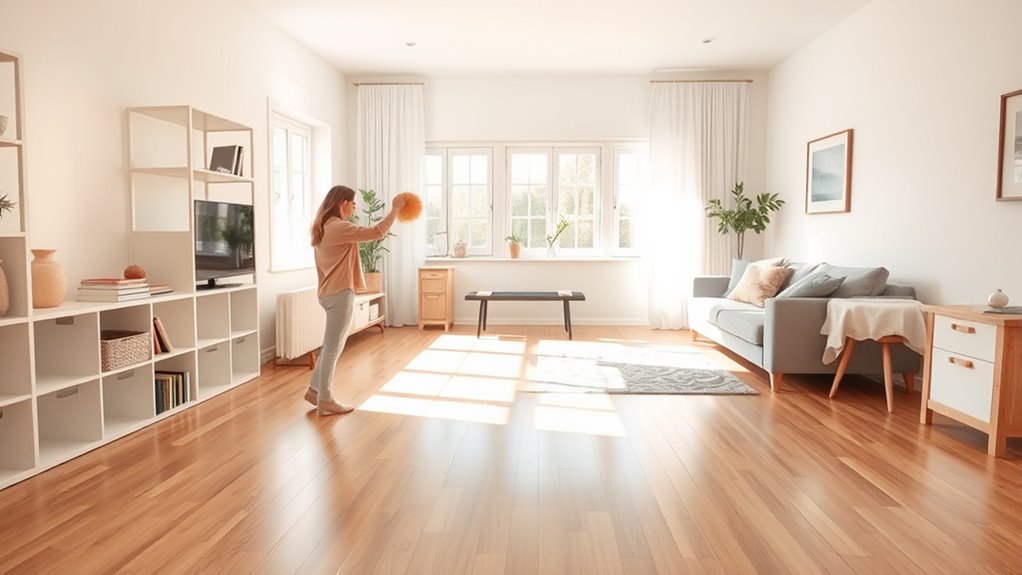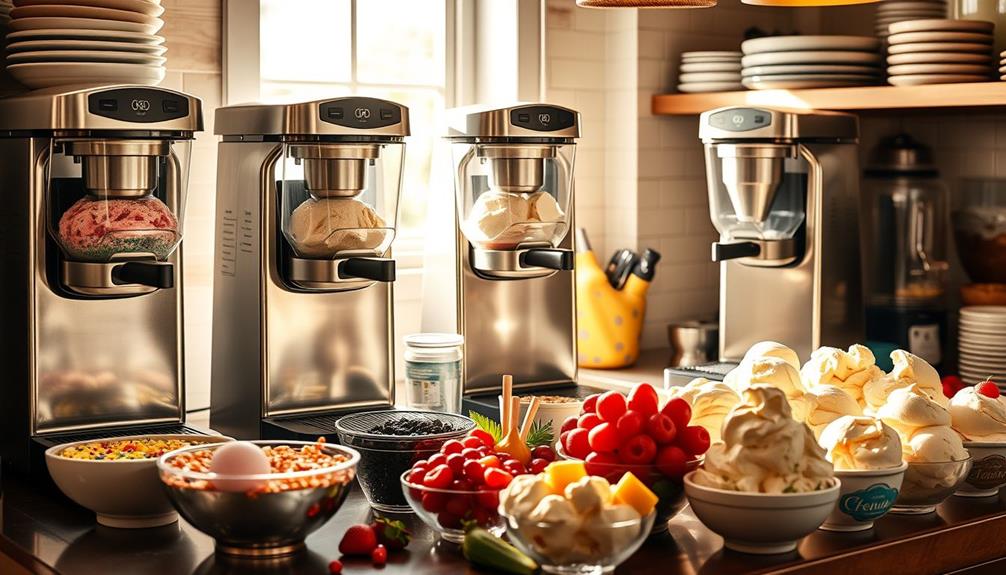Stop trying to declutter your entire room all at once, as it can lead to burnout and rushed decisions. Instead, focus on small areas like a drawer or shelf and establish a clear sorting system—categorize items into keep, donate, and discard. Don’t forget to develop a routine for regular disposal and ongoing maintenance, which helps keep your space organized long-term. Keep these tips in mind, and you’ll find a more effective, stress-free way to declutter.
Key Takeaways
- Avoid tackling the entire room at once; focus on small areas to prevent burnout.
- Don’t skip establishing a clear sorting system; categorize items to streamline decluttering.
- Refrain from neglecting regular disposal routines to prevent clutter from reaccumulating.
- Skip impulsive decisions; take time to thoughtfully decide what to keep, donate, or discard.
- Don’t forget ongoing maintenance; regular upkeep sustains organization and prevents future clutter buildup.
Avoiding the All-at-Once Approach

While it might seem tempting to tackle your entire room at once, rushing into a big decluttering session often leads to burnout and frustration. Instead, focus on small areas to avoid sorting chaos from overwhelming you. When you try to do everything at once, impulsive decisions tend to take over—you might toss items you actually need or keep things you don’t. Break the process into manageable steps, such as a single drawer or shelf. This way, you stay motivated and make thoughtful choices. Taking it slow helps you assess what’s truly important, reducing clutter without feeling overwhelmed. Remember, decluttering is a marathon, not a sprint. Small, consistent efforts will lead to a cleaner space without the stress of a massive, all-at-once effort. Incorporating effective organization techniques can further enhance your decluttering success.
Skipping a Clear Sorting System

Skipping a clear sorting system can quickly turn your decluttering effort into chaos. Without a plan, you’ll likely face sorting chaos, making it hard to decide where items belong. Clutter confusion sets in when everything is thrown together without categories, prolonging the process and increasing frustration. Instead of tackling everything at once, create simple groups—keep, donate, discard. This helps you see what you have and prevents overwhelmed feelings. A systematic approach keeps you focused and ensures items go to the right places. Forgetting to sort as you go can lead to more mess and less progress. By establishing a clear sorting system upfront, you’ll streamline your decluttering and avoid the clutter confusion that stalls your efforts. Incorporating organized storage solutions can further enhance your ability to maintain a tidy space after decluttering.
Ignoring the Value of Categorization

Ignoring the value of categorization can substantially hinder your decluttering progress. Without sorting items into categories, you miss out on the benefits of a clear storage hierarchy, making it harder to find and maintain your space. Proper categorization streamlines your process and reduces clutter faster. To illustrate, consider this categorization benefits table:
| Category | Example Items |
|---|---|
| Keep | Frequently used tools |
| Discard/Donate | Broken or unused items |
| Store Elsewhere | Seasonal decorations |
| Recycle | Paper, plastics |
Using categories helps you decide what stays, what goes, and where everything belongs, creating an organized environment. Don’t overlook the importance of this step—it’s key to effective decluttering and long-term order. Incorporating mental clarity and health principles into your organization process can further enhance your motivation and focus.
Neglecting a Consistent Disposal Routine

Neglecting a consistent disposal routine allows clutter to quickly accumulate again, undoing your decluttering efforts. Without a set disposal schedule, items that no longer serve a purpose pile up, making your space feel cluttered and overwhelming. Developing a decluttering mindset means committing to regular disposal, so it becomes second nature. Schedule specific times to sort through your belongings and discard what’s unnecessary. This ongoing practice prevents clutter from building up and keeps your environment organized. If you ignore this routine, it’s easy to fall back into old habits and lose the progress you’ve made. Consistency is key; by maintaining a disposal routine, you reinforce your decluttering efforts and create lasting order in your space. Additionally, understanding the importance of habituation to decluttering techniques can help turn disposal into a sustainable habit.
Overlooking the Power of Regular Maintenance

While establishing a disposal routine helps keep clutter in check, regular maintenance guarantees your space stays organized over time. Adopting a maintenance mindset means committing to small, consistent actions that reinforce your routine. It’s about staying vigilant and proactive, so clutter doesn’t build up again. Routine reinforcement keeps your space functional and inviting, preventing the cycle of accumulation. To understand this better, consider the table below:
| Daily Tasks | Weekly Checks | Monthly Review |
|---|---|---|
| Clear surfaces | Reassess storage | Declutter forgotten areas |
| Tidy high-traffic zones | Organize supplies | Update organization systems |
| Put items back in place | Deep clean surfaces | Reevaluate organization needs |
This ongoing effort ensures your space remains manageable and clutter-free. Incorporating regular maintenance can significantly improve long-term organization and prevent clutter from recurring.
Frequently Asked Questions
How Can I Stay Motivated During a Decluttering Project?
To stay motivated during your decluttering project, focus on maintaining a positive decluttering mindset and use motivational strategies like setting small, achievable goals. Celebrate each completed step to boost your confidence and keep momentum. Visualize the benefits of a tidy space, which fuels your enthusiasm. Remember, progress is progress, no matter how small. Keep reminding yourself why you started, and you’ll stay motivated to finish the job.
What Tools Are Best for Effective Room Decluttering?
The best tools for effective room decluttering are versatile storage solutions like bins, shelves, and drawer dividers that quickly transform chaos into order. Don’t forget digital organization tools—apps and cloud storage—that help manage your virtual clutter. These tools work together to streamline your process, keep you motivated, and give you clear progress, making decluttering feel less overwhelming and more achievable. Ready to see your space transform?
How Do I Handle Sentimental Items I Want to Keep?
When handling sentimental items, recognize your emotional attachment but prioritize keepsake preservation. Take photos of items you cherish but don’t need physically, so you can keep the memory without clutter. Select a few meaningful pieces to display or store safely, and let go of the rest. This approach helps you honor your feelings while maintaining a tidy, organized space. Remember, it’s about balancing sentimentality with practicality.
What’s the Ideal Timeline for Decluttering a Room?
Timing considerations vary, but a realistic decluttering schedule often spans one to two weekends, allowing you to stay focused without burnout. You might start with smaller sections, like a closet or drawer, then progress to larger areas. Keep your pace steady, and don’t rush—setting achievable goals helps maintain motivation. Remember, the ideal timeline balances thoroughness with practicality, making the process manageable and less overwhelming for you.
How Do I Involve Family Members in Decluttering?
To involve your family in decluttering, encourage family participation by discussing the benefits of a tidy space. Use shared decision making to assign tasks based on each person’s strengths and preferences. Make it fun by setting timers or playing music, and celebrate progress together. This approach fosters teamwork, reduces resistance, and makes decluttering a collaborative effort, ensuring everyone feels invested and responsible for maintaining the cleaned space.
Conclusion
So, instead of tackling your clutter with a frantic sweep or ignoring proper sorting, embrace a calm, organized approach. Ironically, the more you resist the chaos, the faster it clears! By categorizing, sorting, and maintaining regularly, you’ll find your space transforms effortlessly. It’s funny how doing less all at once and more consistently actually declutters your life—without the mess, stress, or regret. Who knew that slow and steady really wins the clean?









